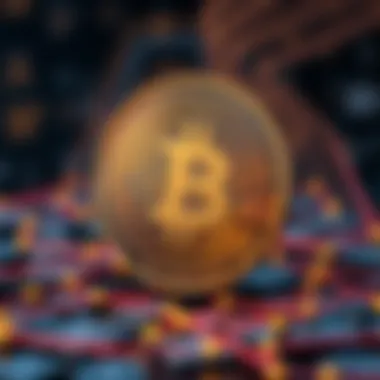Analyzing the USD $1 Coin: Insights and Implications


Intro
The USD $1 coin has stirred a mix of fascination and skepticism since its introduction. While many see it as a stepping stone in the world of digital finance, others are hesitant, often due to its rocky past. In this article, we aim to unpack its nuances, assessing where it fits into the broader narrative of cryptocurrencies, and how it may shape the future of transactions.
To grasp the importance of the USD $1 coin, it’s essential to first take a look at the current landscape of cryptocurrency markets. This digital currency, albeit in its infancy, is poised at a critical juncture—where innovation meets regulation.
The aim here is clear: to provide a thorough understanding of the USD $1 coin from its development to its potential impact on investors and everyday users alike. By dissecting its advantages and obstacles, this article gears itself to equip both novice and seasoned readers with the insights needed to navigate this evolving terrain.
Prologue to the USD $1 Coin
The USD $1 coin represents more than just a piece of currency; it encapsulates a myriad of potentials within the rapidly evolving financial landscape. Understanding the USD $1 coin requires, first and foremost, a grasp of its development and foundational aspects, as these elements set the stage for its practical applications and implications in today’s economy.
The relevance of diving into this topic extends beyond mere curiosity; it touches on vital themes such as economic resilience, digital integration, and evolving transaction methodologies. As traditional monetary systems continue to face pressure from innovation and demographic shifts, the USD $1 coin offers a glimpse into the future of financial transactions. Potential benefits stem from its ability to enhance liquidity, provide stability, and serve as a more accessible medium, especially in an increasingly digitized world.
A Brief History
When examining the USD $1 coin, it is crucial to trace its origins. Initially launched in various forms—most notably the Susan B. Anthony dollar in 1979, followed by the Sacagawea dollar in 2000—this currency aimed to offer an alternative to paper bills, yet it never quite attained the mainstream acceptance anticipated. The cycle of high production costs versus actual usage created a scenario where it circulated in limited capacities.
In response to these limitations, recent innovations have proposed a reinvigorated USD $1 coin that utilizes advanced digital technology. Further developments, including the concept of digital dollars, signify attempts to bridge traditional economies with modern technological frameworks. This history illustrates a continuous quest for balance between practical use and technological advancement in monetary systems.
Fundamental Concepts
To properly understand the impact of the USD $1 coin, one must delve into some fundamental concepts underpinning its design and implementation. At its core, the coin represents legal tender, backed by the full faith and credit of the United States government. This concept of backing fundamentally assures users of its value in everyday transactions.
Another essential factor lies in the functionality and acceptance of the coin within various sectors. For transactions to flow smoothly, both consumers and businesses need to embrace this currency working alongside traditional payment systems. Moreover, discussions around its integration with blockchain technology increasingly shape the narrative around the USD $1 coin, laying groundwork for enhanced security and transparency in transactions.
In summary, the exploration of the USD $1 coin interweaves history and foundational concepts presenting a blueprint for future development in the financial realm. As markets evolve, understanding these elements will equip interested individuals—investors, tech enthusiasts, and academics alike—with vital insights necessary to navigate the changing tides of currency.
Technological Framework
The realm of digital currency, particularly with a focus on the USD $1 Coin, rests heavily on its technological backbone. This framework is not just a collection of intricate codes; it embodies the principles that underline modern finance. Understanding the technological framework is crucial as it delineates how these digital assets operate, and it addresses critical aspects such as security, efficiency, and transparency.
Blockchain Technology Explained
At its core, the USD $1 Coin is built upon blockchain technology. This decentralized ledger serves a pivotal role in ensuring the integrity and security of the currency. Each transaction is recorded in blocks that are then linked together, providing an immutable history of all exchanges made. This creates a transparent environment where manipulation is not just difficult, but nearly impossible.
The use of blockchain brings several advantages:
- Security: The cryptographic techniques used in blockchain significantly reduce the risk of fraud.
- Decentralization: Unlike traditional currencies managed by central authorities, blockchains operate on a peer-to-peer network. This mitigates systemic risks associated with centralized control.
- Transparency: All transactions are visible to users, fostering a sense of trust in the system among users.
This technology also allows for near-instant transactions, which can be transformative for a currency that seeks stability and broad usability in a digital economy.
Smart Contracts and Their Functions
Building upon blockchain technology, smart contracts are another gem within this technological framework. Smart contracts are self-executing contracts with the terms of the agreement directly written into code. They automatically enact and enforce contractual agreements once certain conditions are met. This level of automation can drastically reduce dispute resolution times and lower the need for intermediaries in transactions.
The practical applications of smart contracts are vast:
- E-commerce: They can facilitate automated transactions between buyers and sellers without the need for trust in third-party mechanisms.
- Compliance: They ensure that funding and transaction flows comply with predetermined regulations, simplifying auditing processes.
- Efficiency: By streamlining various aspects of financial agreements, they help users save time and costs associated with manual processes.
By integrating smart contracts with the USD $1 Coin, users benefit from enhanced operational efficiency and reduced transaction friction.
Transaction Mechanics
Diving into the transaction mechanics, the process involved in transferring USD $1 Coins reflects a meticulous orchestration of digital operations. Transactions are initiated by users who utilize digital wallets to send or receive coins. These wallets contain a pair of cryptographic keys: one public and one private. The user’s public key acts as an address for incoming funds, while the private key serves as a signature, authorizing outgoing transactions.


When a transaction is created, it’s sent across the network where it awaits validation by miners or validators. This is how crucial elements fall into place:
- Verification: Nodes in the network verify the transaction details against existing ledgers, ensuring the user has sufficient balance and that the transaction meets other criteria.
- Consensus Mechanism: Depending on the network's protocol, transactions are confirmed through consensus mechanisms like Proof of Work or Proof of Stake, which work to prevent double spending and fraud.
- Finalization: Once validated, the transaction is added to a block and becomes part of the permanent ledger.
This transactional architecture not only boosts the efficiency and speed of exchanges but also enhances user confidence as every transaction is securely tracked.
In summary, the technological framework surrounding the USD $1 Coin is designed to ensure security, efficiency, and trust. It’s a modern blueprint for the future of currency in an ever-evolving digital landscape.
"The strength of a digital currency lies in its underlying technology—the foundation upon which trust is built."
For more on blockchain technology, visit Wikipedia.
Further insights can be explored at Britannica and up-to-date discussions on platforms like Reddit.
Market Dynamics
Market dynamics encompass the forces that influence the market behavior of cryptocurrencies like the USD $1 Coin. Understanding these dynamics is crucial for investors and stakeholders, as they dictate how value is perceived and how trading strategies are formulated. It's a dance between supply and demand, sentiment and speculation. This section dives into trends that are shaping the current landscape.
Current Market Trends
In the ever-shifting ground of cryptocurrencies, keeping an ear to the ground is essential. Here are some salient trends that are currently making ripples:
- Adoption Rates: More merchants and platforms are starting to accept the USD $1 Coin as a mode of payment. This increased adoption signifies a shift towards normalizing cryptocurrency in everyday transactions.
- Regulatory Insights: Governments are slowly but surely laying down regulations. Clarity in the regulatory framework may foster more confidence among investors, perhaps enhancing the market.
- Technology Adoption: New technologies are continuously introducing enhancements in efficiency and security. For example, better wallet solutions and transaction paradigms are enabling smoother, quicker trades.
The takeaway here is that market trends are not one-off occurrences but ongoing conversations, pivotal in guiding strategy.
Price Stability and Volatility
While the USD $1 Coin aims to maintain a stable value, understanding the undercurrents that can sway it is important. Stability comes from various factors:
- Backing Mechanisms: The USD $1 Coin is often pegged to the U.S. Dollar, and thus its value stability is interlinked to the traditional currency. If the U.S. economy is sound, so too is the coin.
- Market Sentiment: However, external forces can wrestle control. A rumor or an economic shift could send ripples, introducing volatility. Traders need to be vigilant, as market sentiment can sometimes act like a glass cannon—fragile but capable of explosive reactions.
- Liquidity: The liquidity in the market also acts as a stabilizing force. High liquidity often means less price fluctuations when larger volumes are traded.
A blend of stability and potential volatility plays a key role in how stakeholders approach investments in the USD $1 Coin.
Comparison with Other Stablecoins
When evaluating the USD $1 Coin, it's also prudent to look at other players in the stablecoin arena. Each one has its own set of attributes:
- Tether (USDT): As one of the earliest stablecoins, Tether is widely used. However, questions have always lingered about its reserves, casting a shadow over its perceived reliability.
- USD Coin (USDC): Lauded for its transparency and regular audits, USDC has bolstered a reputation for stability with backing backed by real assets.
- Dai: Operating on a decentralized platform, Dai's stability is inherently less tied to traditional banking systems. Instead, it leverages smart contracts to maintain its peg.
When you lay these stablecoins side by side, it becomes evident that while all are designed to maintain a stable value, they have different backing, operational mechanics, and levels of trust from the community.
In a nutshell, market dynamics are not just buzzwords; they’re pivotal in informing and shaping how the USD $1 Coin interacts with both investors and the broader financial ecosystem. By understanding these elements, investors can navigate the landscape with more confidence.
Regulatory Landscape
Understanding the regulatory landscape surrounding the USD $1 coin is key for anyone looking to navigate its complexities. Regulation not only shapes the framework in which digital currencies operate, but it also protects investors, ensures fair play, and fosters innovation. When discussing regulations, it’s crucial to recognize the delicate balance between creating a safe environment for users and allowing enough freedom for the ecosystem to thrive.
Government Perspectives
Government views on the USD $1 coin are far from uniform; they're a patchwork of regulations that can differ significantly across jurisdictions. Governments around the world have been wrestling with how best to regulate cryptocurrencies and stablecoins. In the United States, for instance, the Treasury Department and the Federal Reserve have voiced both support and caution towards these digital assets. Some government representatives see potential in stablecoins for financial inclusion, while others regard them with suspicion, especially around issues of money laundering or tax evasion.
The regulatory stance often hinges on the perceived advantages versus the risks involved. On one hand, proponents argue that stablecoins can enhance transaction efficiency and lower costs, making them appealing for businesses. On the other hand, regulators worry about the implications for monetary policy and financial stability. Anything that could interfere with Federal Reserve control over the money supply raises red flags, leading to calls for stricter oversight.
For investors and businesses alike, knowing how local inclinations align with international regulations can determine success or failure in utilizing the USD $1 coin. Keeping up with the whirlwind of regulatory shifts becomes a necessity rather than a choice.


Tax Implications
Tax implications are an essential aspect of the regulatory landscape that cannot be disregarded when considering the USD $1 coin. Different countries adopt various methods to account for cryptocurrencies in their tax codes. In the United States, the Internal Revenue Service (IRS) classifies the USD $1 coin as property, meaning that each transaction can potentially trigger capital gains tax liabilities. This approach brings a level of complexity to everyday transactions that users might not expect.
While there are exemptions for personal transactions under certain thresholds, the intricacies involved often lead individuals to seek advice from tax professionals. Without proper understanding, investors could inadvertently find themselves on the wrong side of the law, leading to hefty fines or back taxes. Moreover, each state may implement distinct regulations that further complicate the landscape, making it critical for users to stay informed on local tax laws and changes.
Even businesses accepting the USD $1 coin should tread carefully. Accounting for profits and losses from transactions conducted with this digital currency requires diligent record-keeping. The potential for audits also looms large, adding another layer of complexity.
"Navigating the minefield of tax regulations is essential for anyone engaging with blockchain-based currencies. It’s not just a matter of compliance - it’s about protection and proper financial planning."
Advantages of the USD $1 Coin
The USD $1 coin represents a bridge between traditional finance and the promising realm of cryptocurrencies. Its significance cannot be overstated, particularly in a climate where fluctuations in currency values and the complexities of digital transactions affect everyday consumers and businesses alike. Understanding its advantages can provide deeper insight into its potential to not only facilitate commerce but also stabilize economies.
Facilitating Transactions
One of the most compelling features of the USD $1 coin is its ability to streamline transactions. Unlike physical currencies which may burden businesses with handling cash, the digital nature of the USD $1 coin allows for quick and efficient transactions.
- Instantaneous Transfers: The coin leverages blockchain technology which enables transactions to be completed in seconds as opposed to the traditional banking systems that might take hours or even days, especially for international transfers.
- Lower Transaction Costs: Businesses can benefit from reduced fees associated with transferring funds. Cryptocurrency transactions are typically less expensive due to lower network fees compared to traditional credit card processors.
- Accessibility: Since digital transactions can be made through mobile devices, more people can engage in commerce without the need for traditional banking services. This could be especially beneficial in areas where banking infrastructure is sparse.
In practical terms, a small business could embrace the USD $1 coin to facilitate seamless transactions, attracting a wider customer base. Local markets could see increased activity as payments become instantaneous and frictionless.
"The future of payments is in digital currencies like the USD $1 coin, which offers unprecedented freedom and efficiency in transactions."
Counteracting Inflation
Inflation erodes purchasing power, making it a persistent concern for many. The USD $1 coin presents a unique way to counteract some of the negative impacts associated with inflation.
- Stability Framework: By being pegged to the US dollar, the USD $1 coin aims to maintain a stable value. This can provide a safer alternative compared to other digital currencies which might be subject to extreme market volatility.
- Protected Value: Holding USD $1 coins can be more advantageous during periods of economic downturn. Investors seeking to preserve their capital can rely on the coin to hold its value against inflation unlike some traditional assets that may fluctuate.
- Economic Inclusion: As more people adopt the USD $1 coin, it creates an ecosystem that could shield them from the pitfalls of inflation. Those who utilize this currency can find financial solace amidst economic uncertainty.
With these advantages in context, the USD $1 coin emerges as a practical solution that meets the demands of modern financial transactions while offering a bulwark against inflationary pressures. Its role is pivotal in reshaping how merchants and consumers interact in the ever-evolving financial landscape.
Challenges and Criticisms
When diving into the intricate waters of the USD $1 coin, it’s crucial to wade through its accompanying challenges and criticisms. These issues not only highlight some of the limitations but also serve to paint a fuller picture of how this digital asset fits into the grand tapestry of our economy. Each problem faced can reveal underlying sentiments about its viability and future success. Investors, tech enthusiasts, and academics must consider these criticisms carefully to inform their decisions or opinions.
Technological Vulnerabilities
One pressing concern is technological vulnerabilities. As with any digital system, the USD $1 coin isn't insulated from the cyber threats lurking in the shadows. A security breach could have dire consequences, leading to loss of trust among users and investors.
- Hacking Threats: Sophisticated hackers continuously develop new methods to exploit vulnerabilities in software, sometimes with little warning. This could lead to unauthorized transactions or loss of data integrity.
- Smart Contract Flaws: The very technology that makes the transactions seamless can also introduce risks. If a smart contract has an unanticipated bug, it could cause unintended financial consequences that affect all users.
The more reliance on technology becomes also means that the security measures must be continually updated. Regular audits and ongoing assessments are essential to ensure that the framework behind the USD $1 coin remains robust against evolving threats.
"The illusion of security is often more dangerous than the lack of it; complacency can have severe repercussions."
Market Correlation Issues
Another area households and investors alike should focus on is market correlation issues. The USD $1 coin is supposedly designed to maintain a stable value, tied to the US dollar. However, the reality may be more complicated. Economic conditions can affect both the traditional currency and the digital asset distinctly, leading to unexpected divergences.
- External Factors: Global economic trends, such as inflation rates and political instability, may have a ripple effect on the price of the USD $1 coin. Changes to interest rates can prompt reactions from traders that don't correlate directly with the intended one-to-one value.
- Investor Sentiment: The mindset of investors can also skew operational behavior. If market sentiment wavers, speculation can lead to volatility that contradicts the coin’s original purpose of being a stable digital asset.
In summary, while the potential of the USD $1 coin shines brightly, these challenges and criticisms must not be swept under the rug. Recognizing the technological vulnerabilities and grappling with market correlation issues provides invaluable insight that can guide future developments and innovations surrounding this digital currency.
Practical Use Cases


The role of the USD $1 coin extends beyond mere representation of value; it serves as a vital instrument in various financial contexts. By examining practical use cases, we can better appreciate the true significance of this cryptocurrency in our digital transactions, allowing both individuals and businesses to streamline their financial routines. These use cases include e-commerce applications and remittances, each highlighting the versatility and functionality of the USD $1 coin.
E-commerce Applications
The rise of online shopping has transformed the retail landscape, creating a need for quick and secure payment options. The USD $1 coin emerges as an attractive alternative to traditional payment methods for several reasons:
- Fast Transactions: Digital transactions using the USD $1 coin facilitate instant payments, eliminating the delays often seen in bank transfers or credit card processing.
- Lower Fees: Unlike credit cards, which can impose hefty transaction fees on businesses, the USD $1 coin offers lower processing costs, which is particularly beneficial for smaller vendors.
- Enhanced Security: E-commerce platforms often deal with fraud concerns. The security features embedded within blockchain transactions can help mitigate these risks, ensuring that both buyers and sellers can engage confidently.
- Global Reach: E-commerce knows no borders. With the USD $1 coin, businesses can cater to international customers without the complications of varying exchange rates and foreign transaction fees.
The adaptability of the USD $1 coin in e-commerce showcases its usefulness as companies strive to meet customer needs efficiently.
Remittances and Cross-Border Transactions
Remittances play a crucial role in the global economy, especially in regions where individuals depend on funds sent from abroad. Here’s how the USD $1 coin can reshape this landscape:
- Reduced Transfer Times: Traditional remittance services may take days or even weeks to deliver funds. With the USD $1 coin, transactions can occur within seconds, enabling quicker access to money for families in need.
- Cost-Efficiency: Many people face steep fees when sending money across borders. The USD $1 coin ensures that more of a sender's money goes to its intended recipient.
- Accessibility: Since wallets for USD $1 coins can be set up easily via smartphones or computers, individuals without access to conventional banking can send and receive funds, promoting financial inclusion.
"As remittances continue to grow, the USD $1 coin could emerge as a pivotal player, offering solutions that traditional systems can't match."
Moreover, the capacity of the USD $1 coin to operate seamlessly in a digital format positions it uniquely in remittances and enhances its desirability among a myriad of users. Both e-commerce and remittances are critical applications of this digital currency, equipping the global community with efficient, cost-effective, and reliable financial solutions.
Future Outlook and Predictions
Understanding the future outlook and predictions surrounding the USD $1 coin is essential for investors, technology enthusiasts, and academics alike. In a rapidly changing digital economy, assessing where the USD $1 coin might head next offers valuable insight into its viability and longevity in the financial terrain. This section lays out the significant factors influencing future developments, potential benefits, and considerations regarding the USD $1 coin.
Technological Advancements on the Horizon
As technology races forward, the USD $1 coin is not likely to sit idle. Several advancements promise to reshape how this coin is utilized and perceived. One key area to watch is the development of layer-two scaling solutions. These technologies aim to enhance transaction speeds and reduce costs, making it easier for users to embrace the USD $1 coin in everyday transactions.
- Improved Security Features: Ongoing innovations in cryptography may lead to more secure transactions, minimizing risks associated with fraud.
- Integration with AI: Artificial intelligence could play a role in predicting market behaviors, allowing investors to make more informed decisions based on data analytics.
- Interoperability Enhancements: With an eye towards better integration between various blockchains, the USD $1 coin might interact more fluidly with other cryptocurrencies and financial platforms.
These advancements can create an ecosystem wherein users feel more confident using the USD $1 coin as a reliable means of exchange. Furthermore, as technological barriers diminish, we might see a broader adoption among less tech-savvy demographics. The introduction of user-friendly wallets and simplified purchasing processes will be vital.
Potential for Integration with Existing Financial Systems
The potential for the USD $1 coin to integrate with current financial systems presents both an opportunity and a challenge. If the broader financial world can embrace this coin, it might pave the way for more widespread use. Here are some aspects to contemplate:
- Collaboration with Traditional Banks: Banks may explore ways to make transactions seamless with USD $1. If they provide services that feature this coin prominently, we could see a symbiotic relationship flourish.
- Regulatory Acceptance: The acceptance of the USD $1 coin by regulatory bodies can lead to its integration into official financial frameworks. As governments continue to explore digital currencies, their support for the USD $1 can provide the legitimacy needed to foster growth.
- Smart Contracts in Financial Services: Leveraging smart contracts for more complex financial products could expand the use-cases for the USD $1 coin, allowing it to become a staple in lending or insurance markets.
The integration into existing systems, however, isn’t without its hurdles. It will take collaboration among financial institutions, policymakers, and tech developers to ensure ease of use and accessibility.
"The future of the USD $1 coin hinges on both technological innovation and its ability to mesh with the established financial order."
These factors, when combined, can greatly enrich the discourse surrounding the sustainability and growth of the USD $1 coin, all while enlightening stakeholders about what to expect in the coming years. Therefore, the horizon appears laden with potential, yet it requires prudent navigation.
Epilogue
The conclusion serves as a vital wrapping up of the insights into the USD $1 coin, stitching together all previously discussed elements while underscoring its significance within the digital currency landscape. This is the point where theories, information, and analysis converge, providing a holistic view of the USD $1 coin's role in today’s financial ecosystem.
Recap of Key Insights
Throughout the sections of this article, several key themes have emerged:
- Historical Context: The USD $1 coin doesn’t just pop up in today’s financial discourse; its roots trace back to a blend of monetary needs and innovations in technology. Understanding how it has evolved helps clarify its present-day implications.
- Technological Backbone: With the support of blockchain technology and smart contracts, this coin exemplifies the shift towards more secure and transparent transaction systems.
- Market Dynamics: As the current market indicates a fluctuating interest in digital assets, the stability of the USD $1 coin compared to the volatility of other cryptocurrencies stands out.
- Regulatory Landscape: The constant evolution of regulations shapes how investors and users engage with the USD $1 coin, making compliance a consideration for its broader adoption.
- Advantages vs. Challenges: While the coin has its benefits, such as facilitating transactions and countering inflation, it also faces criticisms related to technology and market correlations.
In combining these insights, a clearer picture emerges—one that illustrates not only the operational mechanics of the USD $1 coin but also the broader implications for investors and the cryptocurrency market as a whole.
Final Thoughts on the USD $1 Coin
Reflecting on the journey through the mechanisms, regulations, and potentials of the USD $1 coin highlights its critical importance for current and future financial interactions. As digital currencies continue to weave themselves into the fabric of global finance, understanding the nuances of each component can offer a strategic advantage.
The USD $1 coin symbolizes more than just a digital version of currency; it reflects a growing consensus on the necessity for adaptability and innovation in the finance sector. In a world where change is the only constant, the adaptability of the USD $1 coin may just provide a unique avenue for financial empowerment, encouraging investors to reassess the framework of traditional currencies.
Through a lens of continuous evolution, the USD $1 coin may well pave pathways for integrating traditional economic models with contemporary digital innovations. As the landscape evolves, so too will the significance of understanding, analyzing, and engaging with the USD $1 coin—from its ongoing influence to its potential for shaping future financial paradigms.







